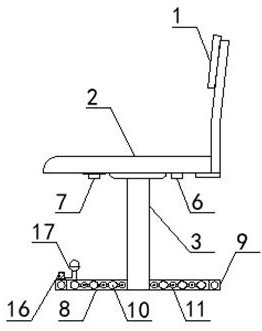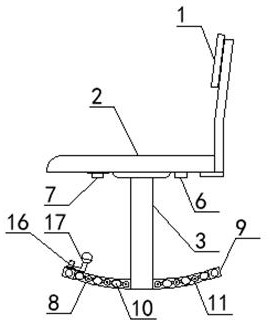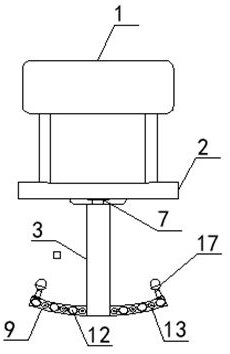Collision-free sound production type seat and working method thereof
A working method and seat technology, applied to chairs, other seating furniture, stools, etc., can solve problems such as seat drop, noise, and impact on public order, and achieve the effect of avoiding harsh noises
- Summary
- Abstract
- Description
- Claims
- Application Information
AI Technical Summary
Problems solved by technology
Method used
Image
Examples
Embodiment 1
[0043] Such as Figure 1-5 As shown, this embodiment provides a collision-free sounding seat, including a seat back 1, a seat plate 2, a support column 3, a deformation mechanism and a control mechanism, and the control mechanism includes a processing unit 4 and a drive unit 5. The processing unit 4 is connected with the drive unit 5, the bottom surface of the seat board is set as a horizontal plane, and an electronic level 6 and a micro-vibration unit 7 are arranged on the horizontal plane, the electronic level 6 is connected with the processing unit 4, It is used to detect the inclination angle of the seat plate 2 relative to the ground position and send the inclination angle to the processing unit 4, and the micro-vibration unit 7 is connected to the drive unit 5 for outputting vibration feedback to the user The deformation mechanism is set in an I shape, and includes a first bending rod 8 and a second bending rod 9, the first bending rod 8 is connected to the bottom of the...
Embodiment 2
[0052] Such as Figure 1-5 As shown, the present embodiment provides a working method of a collision-free sounding seat, including the following working steps:
[0053] S101: The electronic level 6 detects the inclination angle of the seat plate 2 relative to the ground position and sends the inclination angle to the processing unit 4;
[0054] S102: The processing unit 4 determines whether the seat is tilted forward or backward according to the received tilt angle;
[0055] S103: If yes, the processing unit 4 outputs a first rotation signal to the driving unit 5, and the driving unit 5 drives the first rotating device 11 to rotate by a first preset angle, and enters S106;
[0056] S104: If not, the processing unit 4 judges whether the seat is tilted to the left or right;
[0057] S105: If yes, the processing unit 4 outputs a second rotation signal to the driving unit 5, and the driving unit 5 drives the second rotating device 13 to rotate by a second preset angle;
[0058]...
Embodiment 3
[0077] Such as figure 1 , 6 As shown, a first positioning device 14 is also provided on the seat plate 2, and the first positioning device 14 is connected with the processing unit 4 for detecting the first position information of the seat and setting the first position The information is sent to the processing unit 4 .
[0078] A second positioning device 15 is arranged on the desk supporting the seat, and the second positioning device 15 is connected with the processing unit 4 for detecting the second position information of the desk and sending the second position information to the processing unit 4.
[0079] The first positioning device 14 detects the first position information of the seat and sends the first position information to the processing unit 4;
[0080] The second positioning device 15 detects the second position information of the desk supporting the seat and sends the second position information to the processing unit 4;
[0081] The processing unit 4 calc...
PUM
 Login to View More
Login to View More Abstract
Description
Claims
Application Information
 Login to View More
Login to View More - R&D
- Intellectual Property
- Life Sciences
- Materials
- Tech Scout
- Unparalleled Data Quality
- Higher Quality Content
- 60% Fewer Hallucinations
Browse by: Latest US Patents, China's latest patents, Technical Efficacy Thesaurus, Application Domain, Technology Topic, Popular Technical Reports.
© 2025 PatSnap. All rights reserved.Legal|Privacy policy|Modern Slavery Act Transparency Statement|Sitemap|About US| Contact US: help@patsnap.com



